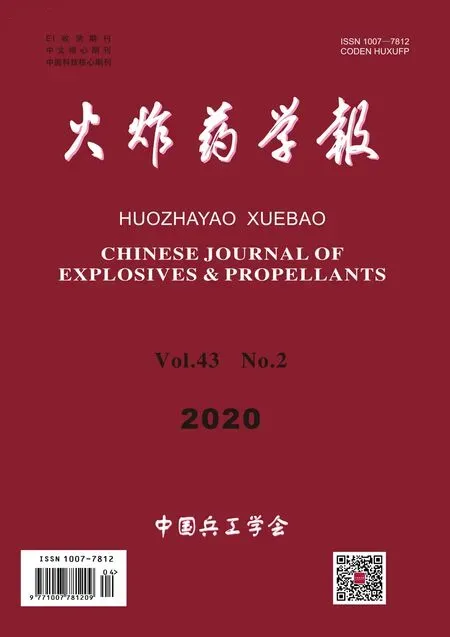Brief Review of N2O Decomposition Catalysts for Engines
A.A. Boryaev
(Saint Petersburg State University of Architecture and Civil Engineering, 4 Vtoraya Krasnoarmeyskaya St., Saint Petersburg,190005, Russia)
Abstract:A brief review of nitrous oxide decomposition catalysts was presented. The features of catalyst operating conditions in low-thrust engines of space vehicles and requirements to monopropellant (hydrogen peroxide, hydrazine, nitrous oxide) decomposition catalysts were considered. A scientific basis for development of a nitrous oxide decomposition catalyst and general principles for selection of efficient catalysts were formulated. The results of selecting catalyst systems for the development of decomposition catalysts for N2O as a monopropellant were presented. Preliminary selection of catalyst systems for the development of a catalyst designed for low-thrust rocket engines (LTREs) was carried out: supporter —Al2O3 and ZrO2; active substances—Co, Ni, Fe, Pd, Rh, Pt, Ru, Ir, NiO, Fe2O3, RuO2, Rh2O3, PdO, IrO2, PtO2, CoO, Al2O3, La2NiO4, Nd2NiO4, Pr2NiO4, La2O3, TiO2, NiO, La2O3, TiO2, ZnO.With 71 references.
Keywords:propellant; nitrous oxide; catalyst; low-thrust rocket engine
Introduction
Nitrous oxide was first synthesized in 1793. Despite its well-studied physical and chemical properties, it was not used for a long time. Only 100 years after the discovery, nitrous oxide was gradually put into practice in medicine due to its anesthetic properties. During the rapid development of rocket and space technology in the second half of the past century, the attention of experts was drawn to highly energetic properties of nitrous oxide,including its ability to show strong oxidizing properties at high temperatures and decompose into nitrogen and oxygen at a ratio of 2∶1 which is close to the air composition. Those properties made it possible to recommend nitrous oxide as a monopropellant which could be used as a basis to design monopropellant and bipropellant low-thrust rocket engines for systems of control effectors in space vehicles (SVs), as well as gas generators ensuring life support on board an SV[1-5].
Due to toughening requirements to the environmental safety of rocket propellants, nitrous oxide gains attention as an environmentally-friendly (“green”) propellant. Nitrous oxide is a stable chemical compound, and in order to ensure its thermal decomposition, a significant amount of energy is required, which is always not enough on board an SV. To decrease energy consumption, it is better to perform the catalytic decomposition of nitrous oxide, which requires highly-active catalysts able to initiate the decomposition process repeatedly. However, high temperature of decomposition products ( 1600℃) and their highly oxidizing environment, as well as harsh operational requirements (multiple and almost instantaneous temperature rises in the catalytic reactor for nitrous oxide decomposition under the influence of various linear, vibration and shock loads) so far have not allowed developing a highly efficient catalyst for its decomposition, to meet the specified requirements.
No unified theory for selection of catalysts has been developed yet. The available variety of catalysis theories (multiplet, electron, activated complex, active ensembles, acid-base catalysis, etc.) make it possible only to reveal the essence of the catalytic act from different perspectives and do not allow predicting the composition of the catalyst with the required properties. To select a catalyst, it is necessary to be familiar with the mechanism of this reaction, which will allow determining principles of catalyst selection. It is known that the catalyst performance significantly depends on its operating conditions. Due to this fact, when developing a catalyst, it is necessary to proceed from the specific factors of the catalysis theory, taking into account the data on the mechanism of the catalytic reaction and the potential operating conditions of the catalyst itself. All this work should be based on the experience obtained from development of various catalysts for chemical industrial processes and especially from development of catalysts for monopropellant decomposition. In particular, when developing an N2O decomposition catalyst, it is necessary to take into account the experience in development of catalysts for decomposition of hydrazine and, especially, highly concentrated hydrogen peroxide, where oxygen forms as one of the reaction products.
The article presents a brief review of the existing catalysts scientific rationale for development of decomposition catalysts for nitrous oxide as a propellant for low-thrust rocket engines, and includes requirements to catalysts, a scientific approach to creation and selection of catalyst systems for the development of catalysts.
1 Requirements to decomposition catalysts
An analysis show that operating conditions of catalysts used in rocket and space equipment (RSE) for decomposition of rocket monopropellants differ significantly from operational modes of industrial catalysts. For example, hydrogen peroxide and hydrazine decomposition catalysts are used in low-thrust rocket engines (LTRE) of SV systems of orientation, correction and approach, as well as in gas generators (GG) of auxiliary power units (APU), life support and tank pressurization systems, etc. The main operation mode of such catalysts is pulse mode, i.e. short-term (from fractions to tens of seconds) propellant supply, followed by a pause (from fractions of a second to several days). In accordance with the requirements to rocket engines (RE), the catalyst shall almost instantly (delay time shall not exceed 0.1 s) initiate the decomposition process at the initial temperature of 5℃ and then, in a few tenths of a second (no more than 0.5 s), allow reaching steady-state operation. Due to the exothermicity of the reaction, the catalyst temperature increases sharply during this period (e.g. during hydrazine decomposition, it increases up to 1200℃). At the same time, the catalyst shall meet a number of requirements,which are usually not imposed on industrial catalysts (Table 1), including the followings:
(1)high reproducibility of catalytic performance in the reactor: dynamic characteristics (decomposition delay time and time to reach the nominal mode), propellant consumption, temperature of reaction products, pressure drop and pulsation level during the entire operating lifetime and at each propellant feed, regardless of the initial catalyst temperature;
(2)stable performance in the given range of temperatures, pressures and vibration loads (acceleration up to 12g with the given values of frequency and amplitude), under various types of radiation in space, climatic conditions, and transportation overloads during ground-based operation;
(3)a high degree of catalyst pellet uniformity in terms of activity, size, shape, strength, etc.
As for a number of basic characteristics (thermal stability, load rate, stability in the pulse mode), the requirements to RSE catalysts are incomparably higher than the requirements to industrial catalysts. For example (see Table 1), the catalyst shall ensure the constancy of all pulse mode parameters for several hundred thousand pulses, at initial launch temperatures from five to hundreds Celsius degrees and under pressure from tens of atmospheres to the pressure of space vacuum. Based on a comparison of operating conditions of industrial catalysts and RSE catalysts, it is clear (see Table 1) that none of the industrial catalysts is exposed to such impacts. Therefore, none of the industrial catalysts found application in RSE. In this regard, it is necessary to develop special catalysts that would meet the full range of requirements for RSE. One of the main requirements to any catalyst is high activity in the process. The complexity of this requirement to RSE catalysts lies in the fact that activity shall be so high that, regardless of the initial temperature of the catalyst (launch in the range from 5 to 1200℃), dynamic characteristics of the process (τd,launch delay time and τr, time to reach the nominal mode) are constant and do not change during the entire operating lifetime.
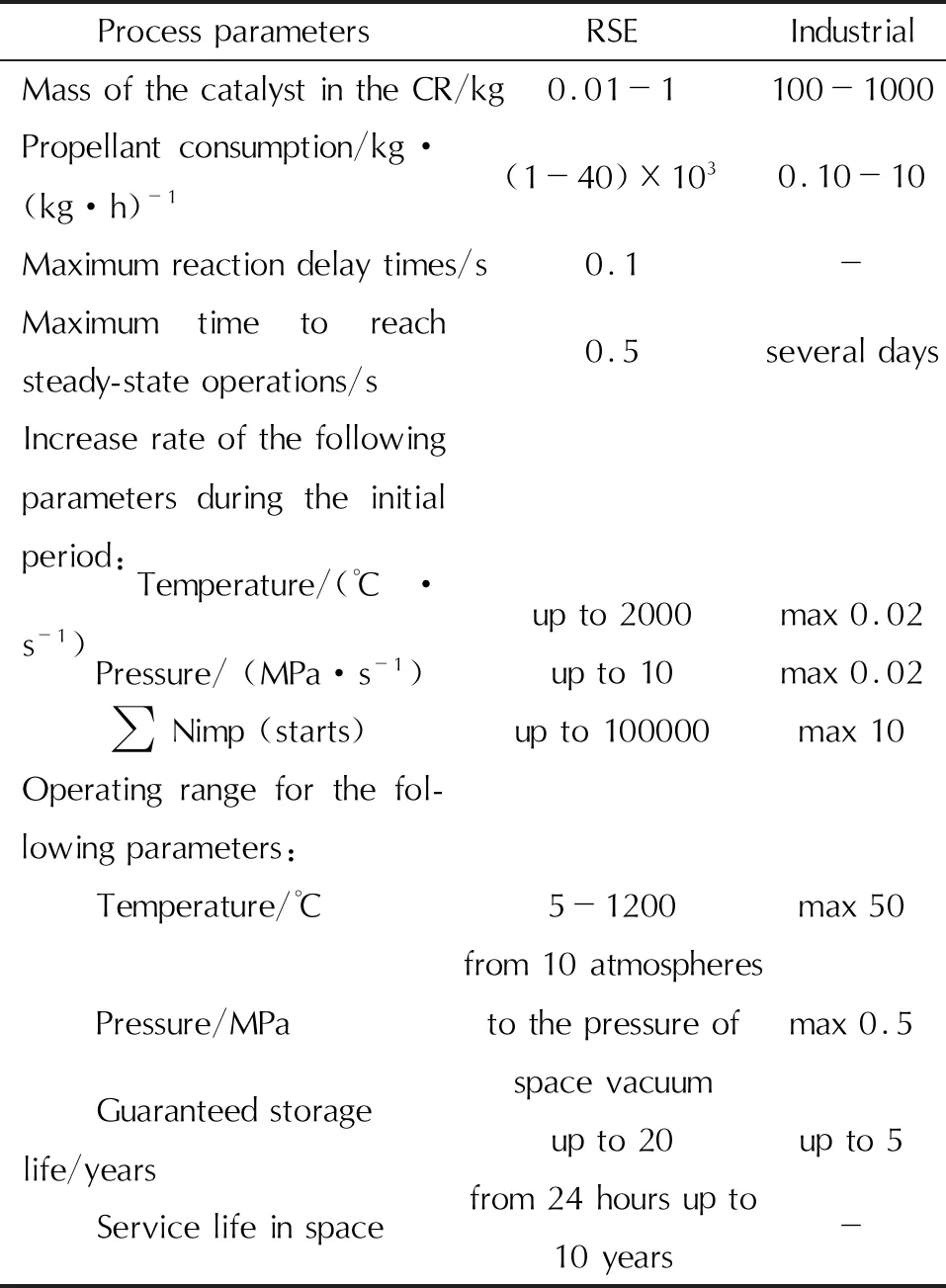
Table 1 Operating conditions of industrial and RSE catalysts
Note: CR,catalytic reactor; max, maximum
To ensure such high activity, which in heterogeneous catalysis is proportional to the catalyst specific surface area, the catalyst shall have a sufficiently developed surface and a certain porous structure, providing both unhindered propellant access to the surface of the active component (AC), and the outflow of reaction product gases from the catalyst grain volume. In other words, its physical and chemical, as well as catalytic properties shall not change throughout the entire operating lifetime. However, it is even more difficult to comply with the requirements regarding preservation of high activity and resistance to mechanical, thermal and chemical factors in the catalyst throughout the entire operating lifetime. The influence of mechanical factors results in destruction of catalyst pellets, increasing pressure drop in the reactor, reducing propellant consumption, and leading to occurrence of pulsations in the engine. Catalyst exposure to high temperatures throughout its lifetime may cause the followings: reduction of its specific surface area and changes in its porous structure, and, as a consequence, reduction of the specific surface area of the active component and catalyst activity; decrease in linear dimensions of catalyst pellets, which leads to the formation of voids in the reactor and, as a consequence, the occurrence of pulsations; as well as changes in the phase composition of the catalyst, which can lead not only to a decrease in activity but also to a decrease in the mechanical strength of the catalyst.
Therefore, the catalyst shall have high thermal stability over the entire range of operating temperatures. The influence of chemical factors is associated with long-term contact of the catalyst with the propellant and its decomposition products in a wide temperature range. Moreover, some requirements to the catalyst depend on the type and purpose of the catalytic reactor (CR). For instance, in terms of energy for LTRE, the temperature of reaction products shall be the highest, and, in terms of energy for GG, the temperature is limited by the need to maintain the performance of structural elements of the system. Based on the above, when developing a catalyst for nitrous oxide decomposition, it is necessary to take into account that during operation it will: be subjected to strong heating (up to 1600℃) and vacuum conditions, therefore, it shall not be volatile in the vacuum and shall have high melting and recrystallization temperatures; the chemical and phase compositions, specific surface area and porous structure of the catalyst shall not undergo significant changes; be at a high temperature in the environment of nitrous oxide and its decomposition products (nitrogen and oxygen), therefore, in order to avoid changes in its chemical composition, it shall not chemically interact with them; as well as experience hydraulic and mechanical impacts, therefore, its mechanical strength under these conditions shall be high.
As the amount of catalyst in the CR shall be minimum, the catalyst shall have high catalytic activity which is determined by the area of the catalyst active surface. Therefore, maximum development of its available specific surface area and maximum uniformity in properties of individual pellets are required. Besides, when developing a catalyst, the requirement to the hydraulic resistance of the catalyst bed in the reactor shall be taken into account, which is determined by the catalyst grain size. It is known that with an increase in the grain size and free volume between grains, the hydraulic resistance of the bed decreases. During development of catalysts for industrial processes, which are produced and loaded in the reactor in hundreds of tons, it is also important to pay attention to their cost and availability of raw materials. As for RSE catalysts, these factors, in our opinion, are of secondary importance. This is due to the fact that several dozens of grams of the catalyst are loaded in the CR and their cost is incomparable with the cost of the SV.
Since the temperature in the reactor catalyst bed (especially in the second part, closer to the end of the catalyst bed) will be very high, it is possible that it may consist of two catalyst types. For instance, a highly-active catalyst responsible for dynamic characteristics of the process will be loaded in the upper part of the CR. In the second part of the CR (closer to the nozzle), a metal catalyst, for example, of the "metal-rubber" type (a wire made of a catalytically active metal pressed into a briquette), or a less active granular catalyst, ensuring engine operation in the high-temperature zone, will be loaded. Based on the above, it can be assumed that the developed highly-active catalyst shall be a supported granular catalyst. As an active component, refractory materials (metals, oxides, or compounds based on them) not forming strong chemical compounds with nitrous oxide or its decomposition products in the process of catalytic decomposition and having high temperatures of phase transformations, will be used. Refractory oxides with a large specific surface area and heterogeneous porous structure can be used as supporters. As a catalyst for the second bed, a metal catalyst of the "metal-rubber" type based on refractory metals, stable in reaction products at temperatures up to 1600℃, or a granular one based on compounds of the spinel type, can be recommended.
2 General principles of catalyst selection
As discussed before, the current state of the catalysis theory does not allow solving the main problem (developing a catalyst with the required properties) on the basis of the theoretical approach. Nowadays, this problem is solved empirically. General ideas about the nature of the catalytic action on the basis of the existing catalysis theories only facilitate its implementation. Therefore, when developing a catalyst, it is necessary to rely on the following general principles.
First, when developing a catalyst, it is necessary to take into account that it shall be capable of forming an intermediate chemical compound with at least one of the initial components. This is due to the fact that forces of chemical interaction between the catalyst and the reacting substances act in the catalysis process. Therefore, when selecting a catalyst, substances inert to this system shall be excluded from consideration. Second, the resulting intermediate compounds of the reactants and the catalyst shall be less durable than the reaction products. Third, the most suitable substances for catalysis (if they meet the first two requirements) are those in which the change of free energy when interacting with the initial components is approximately equal to half the change of free energy in the total process. It should be noted that this requirement is not indisputable, therefore, this principle is used for catalyst pre-selection. Although, by changing the catalyst composition with the introduction of additives that change the amount of free energy, it is possible to increase the efficiency of the catalyst. Fourth, this requirement relates to the rate of interaction between the catalyst and the reactants: the interaction shall be fast, i.e. with low activation energy. If the catalyst is not able to lower activation energy, the process is not carried out. The fifth requirement is related to the spatial orientation of the intermediate complex. It is determined by the principle of structural correspondence in the Balandin′s theory. According to this principle, the structure of the catalyst and the active complex forming on the surface of the catalyst shall be such that the complex could be formed without large energy consumption. However, this principle is not so important for reduction-oxidation reactions occurring in metals or semiconductors. For these reactions, the solubility of one of the components in the catalyst lattice plays an important role.
Thus, by gradual selection (mainly qualitative) from a large number of active substances, it is possible to select those that meet the considered requirements. By following this path, it is possible to facilitate selection of active catalysts. Based on the considered principles, substances with free or loosely-bound electrons shall exhibit high activity in the oxidation-reduction reaction. Metals and semiconductors meet these requirements: the former have free electrons, and the latter have loosely-bound electrons. It should be kept in mind that the introduction of additives into the catalyst can facilitate the transition of electrons, i.e. reduce the activation barrier.
3 Scientific basis for selection of an N2O decomposition catalyst
The reaction of catalytic decomposition of nitrous oxide has been widely studied, and mainly as a model reaction, as during the decomposition course no by-products occur[6-19]. This allows performing mathematical modelling of the catalytic process. However, no fundamental investigations aimed at development of a catalyst for N2O decomposition have been carried out. This is due to the fact that, first, the reaction itself had no practical significance until recently. Second, till the present, the catalysis theory which allows predicting catalyst activity based on the assessment of energy and entropy of active complexes formation at all stages of the catalytic process, has been absent. Catalyst activity prediction turned out to be a very difficult and still unsolved task. In the meantime, the scientific basis for prediction of chemicals′ catalytic action is based on approximate estimates of changes in energy of the active complex and a correlation of specific factors based on studies of the reaction mechanism.
Let us consider data on the correlation of catalytic activity with electrical properties and energy of the intermediate interaction between the reactants (or their products) and the catalyst. When developing a catalyst, it is necessary to proceed from the fact that, during N2O decomposition, the activated N—O bond shall break first. The correlation of catalytic properties of a heterogeneous catalyst with its electrical properties is based on well-known provisions determined by the fact that the intermediate interaction of initial substances with the catalyst is mainly due to properties of electrons (or holes) of the catalyst-semiconductor. In other words, chemisorption of the reactants on the catalyst (as the first stage of catalysis) occurs due to their interaction with free electrons or holes of the semiconductor. This interaction is a limiting stage of the catalytic process.
Based on this provision, the authors of the electron theory of catalysis proposed a simple dependence of the chemisorption equilibrium on the position of the Fermi level. Those views have become quite widespread in catalysis. It seemed very easy to adjust adsorption and catalytic properties of the catalyst-semiconductor by shifting the Fermi level. It was also possible to shift the Fermi level by introducing cation additives or by changing the stoichiometric composition of binary systems, which means selecting the optimal catalyst. Those theoretical assumptions were confirmed for many reactions and, in particular, during studies of N2O catalytic decomposition on metal oxides. For instance[20], when investigating the N2O decomposition reaction on hole semiconductor (p-type) NiO found that it appeared to be a donor reaction. The introduction of Li2O additives increases NiO catalytic activity, and the introduction of In2O3reduces it.
However, later it turned out that the connection between catalytic and chemisorption properties of a semiconductor and its electron properties was not as simple as suggested[21]. For example, the introduction of Li2O and Cr2O3additives in ZnO and Al2O3and the introduction of WO3additives in TiO2reduced ZnO and TiO2activity in the N2O decomposition reaction. Although, according to the change of the Fermi level, it had to increase. Numerous discrepancies in experimental results significantly reduced the predictive power of the electron theory in terms of selecting catalysts. Nevertheless, based on the provisions of that theory and experimental data published by various researchers[22], presented a series of activities of semiconductor oxides in the N2O decomposition reaction (according to the reaction start temperature), which, in our opinion, has practical significance:
NiO, CuO, CoO (t< 400℃); CaO, CuO, MgO, CeO2(t=450-550℃);
Fe2O3, TiO2, Cr2O3, Al2O3, ZnO (t>550℃).
As is seen, the most active are oxides with p-semiconductor conductivity, followed by dielectrics and n-semiconductors; their activity is on average 1-2 orders less than activity of p-semiconductors. The difference for oxides of IV period metals is especially large. However, even the above series has some exceptions. For instance, CuO is an intrinsic semiconductor assigned to the second group, and Cr2O3is an intrinsic semiconductor showing p-conductivity[23], assigned to the third group of low-activity catalysts. In addition, Al2O3acquires electrical conductivity during heat treatment, which allows it to be excluded from the number of insulators. In subsequent studies, it was found that MgO also belonged to low-activity catalysts (t>550℃). BeO, GeO, SiO2dielectrics are even less active, and basic oxides are more active than acidic ones. Based on those data, it can be assumed that while maintaining the general trend of catalytic activity reduction in transfer from p- to n-semiconductors, insulators may be less active than n-semiconductors. It was also found that catalytic activity of oxides in reduction-oxidation reactions changed with the change of the conductivity type when the chemical structure of the oxide-semiconductor itself changed.
In addition, it turned out that electrical conductivity of semiconductors also depended on oxygen pressure in the system: with an increase in oxygen pressure, conductivity of n-type oxides decreases and conductivity of p-type oxides increases. Both these factors are particularly important in development of an N2O decomposition catalyst where one of the reaction products is oxygen. On the one hand, the formation of oxygen will result in changes in its pressure during propellant decomposition, and, on the other hand—in oxidation of the catalyst surface, i.e. in changes in its chemical composition, especially under the influence of high reaction temperature. Therefore, the problem of catalyst resistance to the influence of the reaction medium is brought to the forefront, which cannot but affect the process of selecting the catalyst composition.
When selecting catalysts based on the principles of the electron theory, it is important to know how the type of conductivity in metal oxides changes depending on the metal position in the periodic system as this facilitates the process of selecting active components. Unfortunately, the information about conductivity is not available for all oxides, and for some of them, it is contradictory. However, in general terms, oxides of transition metals at the beginning of large periods (TiO2, V2O5, Cr2O3, MnO2, and Fe2O3) are n-conductors, but at the end of periods (CoO, NiO and Cu2O) are p-conductors, and ZnO is an n-semiconductor. In other words, with the growth of the atomic weight of a metal forming the oxide within the same group, activity of oxides in the N2O decomposition reaction shall increase.
Thus, based on the electron theory of catalysis, metal oxides with p-conductivity will show high activity in the N2O decomposition reaction. Moreover, their activity will increase with an increase in the atomic weight of a metal in the same group or period. According to an analysis of literature data on activity of catalysts in the N2O decomposition reaction, the limiting stage is desorption of O2with the transition of a positive hole of the catalyst to it. According to the data on oxygen isotope exchange at high temperatures, the oxygen desorbing during the reaction does not differ from the oxygen of the catalyst surface layer. This fact allows suggesting that at temperatures above 400℃, the N2O decomposition reaction can proceed by exchanging oxygen ions of the surface layer and the gas phase. It is known that if N2H4decomposition requires activation of the N=N and N-H bonds[24], then N2O decomposition requires activation of the N=O bond. Activation of this bond can occur as a result of the formation of an intermediate compound between N2O and the catalyst. Knowledge of the magnitude of the binding energy between this complex and the catalyst can also facilitate the process of selecting the optimal catalyst. Since in our case the intermediate compound is formed with the help of oxygen, catalytic activity shall depend on the magnitude of the binding energy between O2and the catalyst. It is known that catalytic activity decreases with an increase in the magnitude of the binding energy between oxygen and the catalyst. However, it is difficult to estimate the magnitude of the binding energy between oxygen and the catalyst under the reaction conditions. Therefore, it is estimated approximately based on thermochemical data or studies on the oxygen isotope exchange.
Data on catalytic activity of homomolecular oxygen isotope exchange can be used as a characteristic of the binding energy and reactivity of the oxide surface. According to their activity in the reaction of homomolecular exchange (the data on which can serve as a basis for the selection of an active catalyst), oxides of transition metals containing ions with partially filled d-shells are the most active. Oxides of rare-earth elements are also highly active. In the meantime, oxides containing metal ions with filled f- and d-shells are relatively low-active.
On the basis of experimental data on homomolecular O2, it was found that, in the oxidation reaction, specific catalytic activity of metals decreases in the following series:
Pt>Ag>Pd>Au.
If we proceed from the data on the binding energy (kJ/mol) of O2on the surface of oxides of IV period elements, we can compose the following series of oxide activity:
Co3O4(17)>CuO(19)>NiO, MnO(20)>Cr2O3(26)>Fe2O3(34)>V2O5(43)>ZnO (54)
For all oxides, the binding energy of oxygen increases monotonically with an increase in the amount of removed oxygen and approaches the heat of dissociation during the formation of a new phase. The correlation between activation energy of oxides in the N2O decomposition reaction and the O2binding energy in them allowed to conclude that catalytic activity of oxides increases with a decrease in the binding energy of the oxygen-catalyst bond[25]:
Co3O4>NiO>CuO>CdO>Fe2O3>SnO3>CeO2>ZnO>WO3.
The exception is provided by Cr2O3, the binding energy of oxygen in which is ~147kJ/mol and less than for Fe2O3, CdO, SnO2, CeO2. However, activity of chromium oxide is inferior to the above oxides. Thus, based on the correlation of the O2binding energy in oxides and their activity in the N2O decomposition reaction, the greatest activity is shown by the same oxides, which are selected on the basis of the electron theory of catalysis. It is known that oxygen, in the process of chemical reactions with its participation, sorbing on the surface of the catalyst, can penetrate several atomic layers deep into the crystal lattice even at room temperature. Therefore, the bulk oxygen of the oxide catalyst shall participate in the process. In this regard, it can be assumed that mobility of oxygen in a heterogeneous system can be characterized by the dissociation temperature of the surface bulk oxide, at which the equilibrium partial pressure of oxygen over the oxide (PO2) is equal to the total gas pressure (Ptot). The calculated dissociation temperature (Td) can be used during catalyst selection.
In the general case, equilibrium dissociation of the oxide is described by the following equation:

(1)
wherex>0,y≥0.
Partial pressure of oxygen over the oxide varies according to the following equation:
(Po2/101325)γ=eΔS/R·e-ΔH/RT
(2)
where ΔSand ΔHare changes in entropy and enthalpy of the oxide dissociation reaction.
Equilibrium of this reaction is determined by the equality of the total pressurePtotand partial pressure of oxygenPo2(i.e.Ptot=Po2). The dissociation temperature (Td) can be calculated according to the following equation:
Td=ΔH/[ΔS-γ·R·ln(Ptot/101325)]
(3)
Since oxygen is mobile enough not only during dissociation, it is necessary to determine the temperature range of oxygen mobility to characterize the oxygen bond and use this value during catalyst selection, taking a distinction interval betweenPtotandPo2as one order of magnitude. The temperature range of oxygen mobility (Tm) can be calculated according to the following equation:
Tm=ΔH/S±γ·2.3R
(4)
For example, for platinum, theTminterval is (300-450)℃ (PtO—Pt3O4), (400-500)℃ (Pt-Pt3O4) and (480-620)℃ (Pt-PtO);for iridium=(600-820)℃ (Ir-IrO2);for palladium=(500-650)℃ (Pd-PdO);for rhodium=(480-600)℃ (RhO-RhO2), (680-850)℃ (RhO-Rh2O3).
Thus, for isothermal processes involving oxygen, each temperature corresponds to the extremely active state of the heterogeneous catalytic system, at which Td is equal to the process temperature. According to the selected temperature of the process with the participation of oxygen, it is possible to immediately select elements promising for development of active catalysts. It should be noted that the range of elements selected as promising for development of an active catalyst can be significantly reduced if the elements and their oxides, chemically interacting with the initial final products of the reaction, as well as those elements and oxides that are volatile at the process temperature, are excluded from it. The given assumption about the possibility of selecting a catalyst based on the dissociation temperature of oxides, along with other properties of the solid phase, was tested on a number of catalytic reactions with acceptable results. On the basis of the calculation, it is possible to assume that based on the temperature of the N2O decomposition reaction (800-1200℃) and the dissociation temperature Td, the most suitable systems for development of catalysts are the following:
PtO-Pt; IrO2-Ir; Rh2O3-RhO; Co3O4-CoO; MnO2-Mn3O4; MnO2-MnO;
V2O5-V2O4; TiO2-Ti2O3; AgO2-Ag; CuO-Cu2O.
The active state of the heterogeneous system is mandatory, but not the only condition for the implementation of the catalytic process, since the choice of temperature is dictated primarily by the reactivity of substances, i.e. kinetic factors. Besides oxygen, nitrogen can also be chemisorbed on the catalyst during N2O decomposition. This process mainly occurs in metals such as Pt, Ag. Sufficiently high desorption activation energy is indicative of the activated character of adsorption: 75-105 kJ/mol for platinum and high adsorption (300℃ for Ag) and desorption (400-1000℃ for Pt) temperatures. Nitrogen and oxygen are adsorbed simultaneously on silver. On platinum, nitrogen adsorption can be accompanied by the release of nitrous oxide according to the following reaction:
Pt+N2O→Pt-N+NO
(5)
Therefore, when selecting a decomposition catalyst for N2O, possible sorption by the nitrogen active component shall be taken into account as well. However, it should be noted that the use of other theories of catalysis during selection of an N2O decomposition catalyst has not been successful. For example, no correlation between oxide catalytic activity and the crystal lattice parameters has been established. No correlation between the catalytic activity and the Δx electronegativity difference has been observed as well. The values of the activation energy of N2O decomposition, available in the literature, are ambiguous and even less reliable than the data on catalytic activity. They vary within wide limits from 60 to 105kJ/mol for Co3O4, NiO, CuO, ThO2, to 200-250kJ/mol for oxides such as Gd2O3, CeO2, SiO2. As for the first group of oxides, the reaction proceeds at 200-300℃, as for the second group of oxides, it proceeds at 700-800℃, which is close to the temperature of the beginning of N2O homogeneous decomposition. The pre-exponential factor for all those oxides is approximately equal. Consequently, catalytic activity is mainly determined by activation energy.
Thus, the selected oxides based on the electron theory of catalysis and confirmed by the data on the binding energy between oxygen and the catalyst surface can serve as a basis for development of N2O decomposition catalysts.
4 Selection of catalyst systems
A large number of theoretical and experimental studies address the N2O decomposition reaction. The findings of those studies can serve as a basis for development of an effective catalyst system (supporter—active component) if N2O is used as a monopropellant in RSE. The article presents an analysis of literature data on N2O catalytic decomposition that was carried out to determine what properties of a solid body to consider when selecting catalysts for the N2O decomposition reaction under conditions of LTRE operation. Rough conditions of N2O decomposition catalyst operation impose high requirements to strength, catalytic activity, and thermal stability of developed catalysts. It is known that in order for a sufficiently strong and stable structure to form, that can resist destruction when subjected to a high-temperature gas flow, it is necessary to use catalysts supported by a solid granular material with high porosity and a high specific surface area,which was made of a thermally stable substance.
Physical and chemical properties of supported metal catalysts for N2O decomposition and oxide supporters most commonly mentioned in literature are presented in Table 2. Data on the most widely used catalyst supporters is described below. Almost all of those have high thermal stability. Exceptions are GeO2and Co3O4, however, the latter, losing oxygen when heated, at ~ 900℃ turns into CoO with high thermal stability. Al2O3and ZrO2are used more often than other supporters. An analysis of the literature data presented in Table 2 allows us drawing the following key conclusions. The use of Al2O3as a metal catalyst supporter represents the simplest case of monofunctional catalysis when Al2O3is not involved in the mechanism of the catalytic process. Functions of aluminum oxide are to dilute, disperse and stabilize the supported metal. Besides, aluminum oxide facilitates access of reagents to catalytic centers and outflow of reaction products from those due to its internal porosity. This function of the supporter is very important in case of the N2O catalytic decomposition reaction limited by reagent diffusion (and according to other sources—by desorption of oxygen from the catalyst surface).
SiO2is used as a supporter in various modifications (more than 10). However, high-temperature cristobalite, the temperature stability interval of which is 200—1720℃, is the most suitable for the purposes mentioned above. But it is inferior to Al2O3in terms of the specific surface area and formability. TiO2used as a supporter usually does not have a large surface. MgO supporters can be easily extruded and molded in the form of pellets as MgO is characterized by adhesion. Extruded supporters are quite strong. When drying, it acquires a developed surface and has a large volume of pores (mainly those with a small diameter) due to heavy loss of moisture. Alkaline-earth metal oxides are characterized by chemical reactivity. They have a tendency to form peroxides, and in the presence of CO2they form carbonates. ZrO2oxide has a high melting temperature and does not undergo phase transformations, but its use as a supporter is constrained since it is difficult to obtain it with a highly-developed surface (there are at least three laborious methods to obtain ZrO2with a surface of up to 100 m2/g). ZnO is rarely used as a catalyst supporter. Zinc oxide is of amphoteric nature. This feature determines the possibility of numerous solid-phase reactions with other oxides in a catalyst system. Therefore, it is often used as a component of a catalyst. Cr2O3is extremely thermally stable and allows using catalysts supported at temperatures up to 1000℃ with minor changes in the catalyst composition. At high temperatures, it can form complex catalyst systems with other oxides; therefore, it is widely used in catalysis.
Among oxides not listed in Table 2, such high-temperature compounds as rare-earth element (REE) oxides and ThO2can be considered as potential supporters. REE oxides have a high melting temperature and high thermal stability, but they are quite expensive. ThO2has both positive and negative properties. Its main positive property is an extremely high melting temperature (3000℃). Besides, ThO2does not interact with the active component supported. At the same time, this oxide is characterized by low radioactivity. Thus, based on the brief characteristics of oxides used as supporters for metal catalysts, it can be seen that Al2O3, Cr2O3and ZrO2are the most suitable for the purposes described.
When selecting active components for catalyst systems, it is worth considering a classification of catalytic processes based on the mechanism of catalyst action[26]. According to this classification, the N2O decomposition reaction belongs to the oxidation-reduction type. It is catalyzed by solids having free or easily excitable electrons, including metals and semiconductors. When selecting effective catalyst systems, it is advisable to consider two types of properties of solids that could be included in those systems. The first type includes properties that directly determine catalytic activity, e.g. such properties as the number of current carriers, electronic work function, band-gap energy, etc. The second type includes such properties as color, melting point (including the temperature of phase transformations). Properties of the first and second type are equally valuable for the practical problem of catalyst selection. The choice between them is mainly determined by the amount of available information on the catalytic process under consideration.
Among metal catalysts given in Table 2, Co, Ni, Fe, Pd, Rh, Pt, Ru, Ir, In, Mo metals have high melting temperatures and, when heated in air (as the chemical composition of air is close to the chemical composition of N2O decomposition products), they are usually oxidized form a surface oxide film (see Table 2). Moreover, they have higher catalytic activity in the oxidized condition. Based on the electronic structure of atoms, preference should be given to transition metals of VIII group of IV, V, and VI periods. La, Ce, Ag metals are not suitable for use due to low melting temperatures (1000℃).
Literature data on catalytic properties of single and double spinel-type powder oxides, as well as their physical properties such as melting temperature, color, and thermal stability, are given in Table 3. When selecting active oxide systems (both simple and spinel-type), we proceeded from the fact that in oxidation-reduction reactions, active substances, according to literature, are usually colored. The most active substances are colored intensively, with predominant black and brown tones. They are followed by less active substances of red, orange and yellow colors. White substances are low-active or inactive. Among the active oxides selected by color, oxides with a melting temperature exceeding 1100℃, thermally stable in the same temperature range and thermally sensitive to the formation of active substances with respect to the N2O decomposition reaction, with a high melting temperature were selected. Then, substances with a high initial temperature of N2O decomposition process initiation (more than 600℃) were excluded from the selected oxides, and spinels were excluded if the temperature of their calcination was less than 1100℃.
Among oxides given in Table 3, Co3O4, NiO, CuO, CdO, Fe2O3, Cr2O3, U3O8, V2O5, Cu2O, Bi2O4, PbO2, RuO2, Rh2O3, PdO, Ag2O, IrO2, PtO2, Au2O3, Mn3O4, CoO Al2O3, NiO Cr2O3, CuO.Cr2O3, CuO Al2O3, NiO Al2O3are colored intensively. Among those, Bi2O4has low melting (boiling) temperature; Co3O4, CuO, CdO, U3O8, V2O5, Cu2O, PbO2, Ag2O, Au2O are thermally sensitive; spinels of NiO Cr2O3, CuO Al2O have low calcination temperature; Cr2O3, and NiO Al2O3spinel have low initial temperature of N2O decomposition process initiation. Thus, the following oxides or their mixtures with other oxides can be selected for further research: NiO, Fe2O3, RuO2, Rh2O3, PdO, IrO2, PtO2, Mn3O4, Co3O4, Cr2O3, CuO.Cr2O3, CoO Al2O3. All those oxides mainly have p-conductivity.
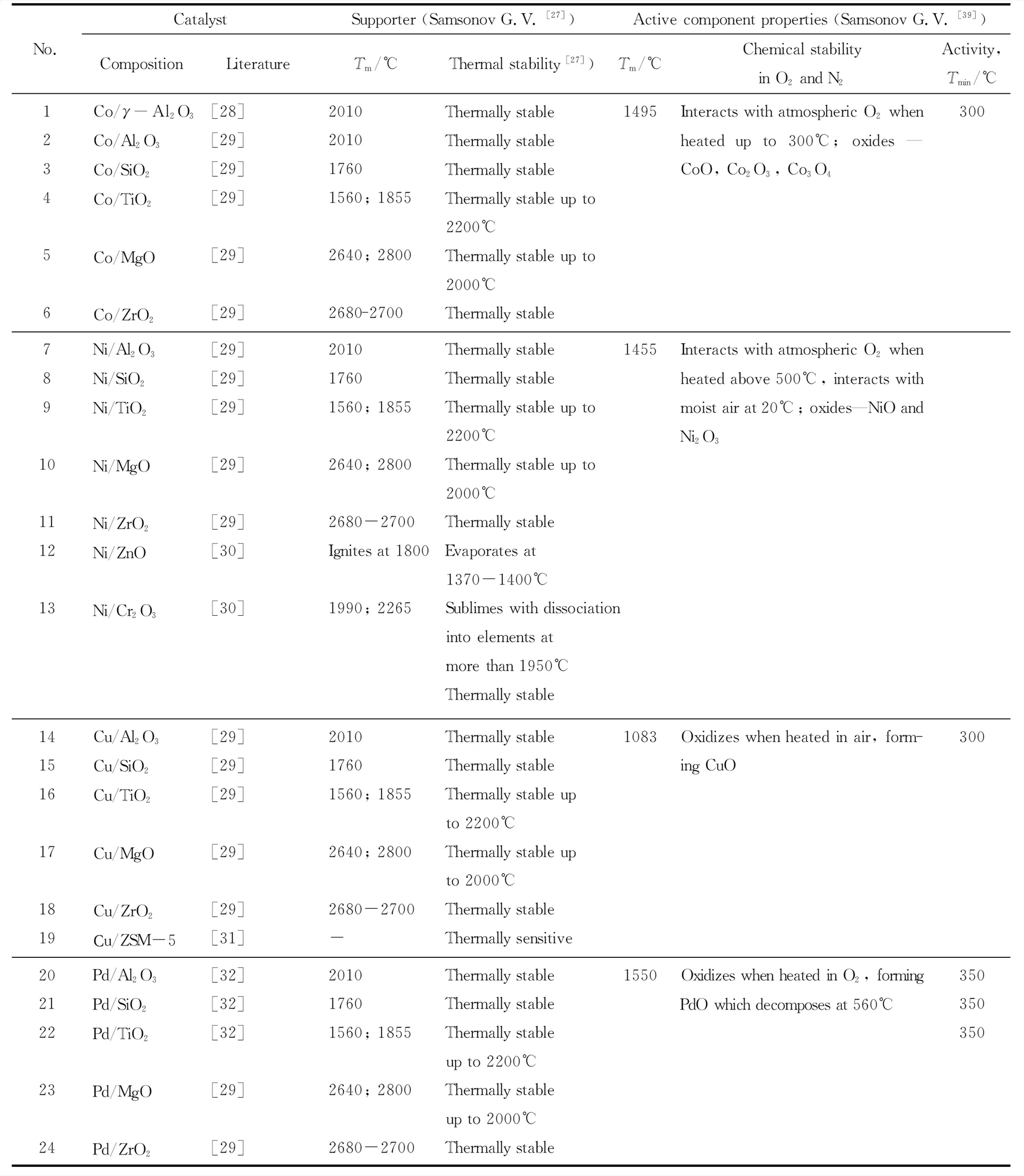
Table 2 Physical and chemical properties of supported metal catalysts

Continuetotable2No.CatalystSupporter(SamsonovG.V.[27])Activecomponentproperties(SamsonovG.V.[39])CompositionLiteratureTm/℃Thermalstability[27])Tm/℃ChemicalstabilityinO2andN2Activity,Tmin/℃25262728Rh/-Al2O3Rh/ZnORh/GeO2Rh/ZSM-5[33][31][31][31]2010Ignitesat1800ThermallystableSeesupportersampleNo.12SeesupportersampleNo.191966InteractswithatmosphericO2at800℃,formingRh2O3stableattemperaturesover1000℃300300300293031323334353637Fe,Rh/ZrO2Fe,Pd/ZrO2Fe,Pt/ZrO2Fe,Co/ZrO2Fe,Ni/ZrO2Fe,In/ZrO2Fe,Mn/ZrO2Fe,La/ZrO2Fe,Ce/ZrO2[34]2680-2700Thermallystable1539,19661539,15501539,17701539,1539,14551539,15001539,12441539,9201539,804Interacts:withN2,formingFe4NandFe2N;withdryairat150-200℃,form-ingaprotectiveoxidefilm;withmoistair,formingFe(OH)3rust.ThermalstabilityofCo,Ni,Pd,Rh,seeabove(column7);InoxidizestoIn2O3atTmof156℃;Ptdoesnotinteractwithair;MninteractswithO2whenheatedwiththeformationofMnO2andMn2O3;Lainteracts:withN2,whenheated(LaN);withmoistair-La(OH)3;withO2at450℃-La2O3;Ceinteracts:withN2at160℃-CeN,burnsinO2-CeO2.38Ir/-Al2O3[33]2010Thermallystable2454InteractswithO2attemperaturesabove800℃,formingIrO230039Ag/Al2O3[35]2010Thermallystable961OxidizesinairwiththeformationofAg2O,whichdecomposesattemperaturesabove200℃40Ag/Co3O4[36]-Losesoxygenwhenheated.At900℃,ittransformsintoCoO,whichdecomposesat2800℃961-41Mo/SiO2[37]1760Thermallystable2617InteractswithO2at300℃,formingMoO3at600℃-42Ru/ZSM-5[38]2010Thermallysensitive2427InteractswithO2attemperaturesabove800℃,formingRuO2250

Table 3 Properties of simple oxides and their catalytic activity in the N2O decomposition reaction
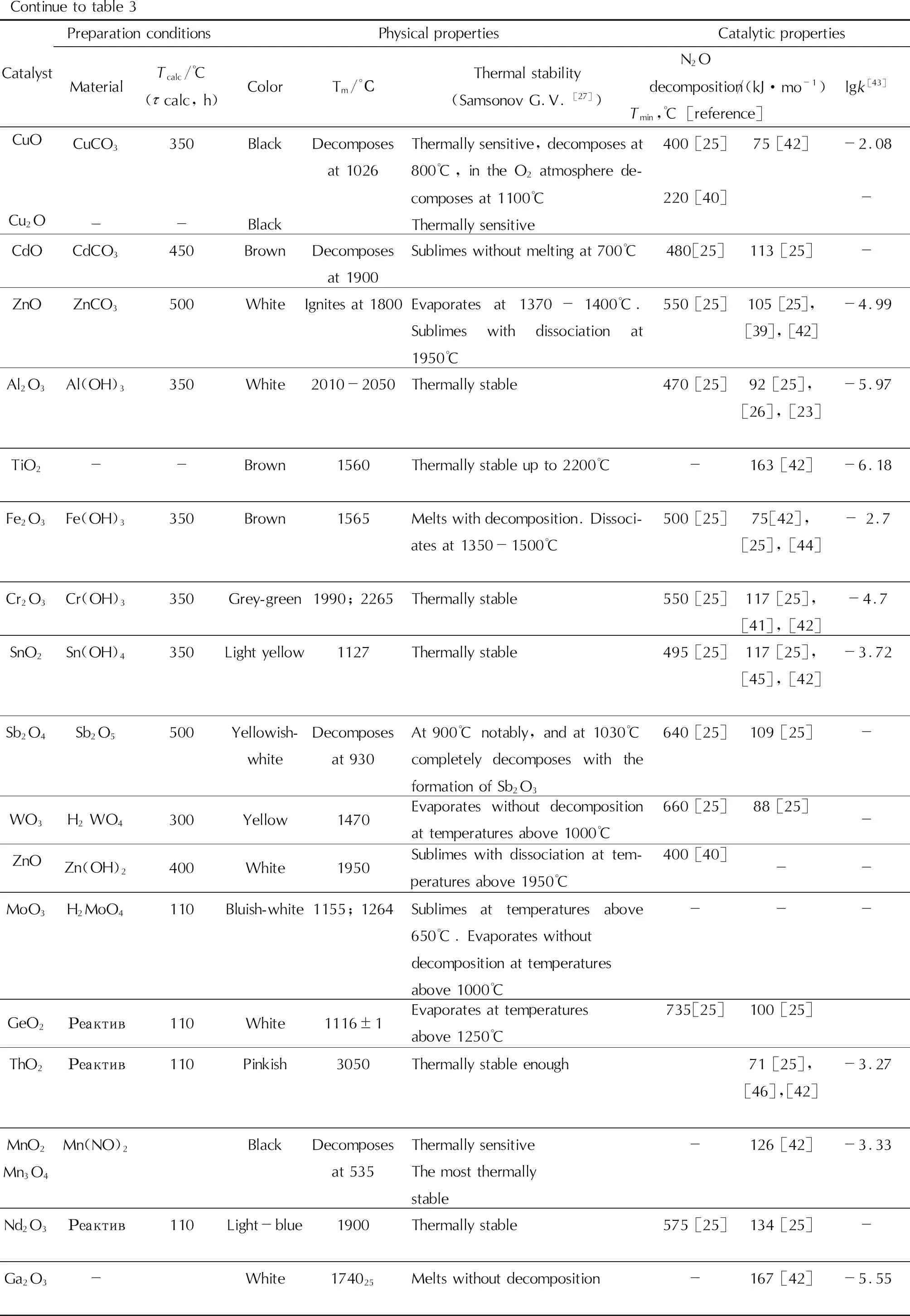
Continuetotable3CatalystPreparationconditionsPhysicalpropertiesCatalyticpropertiesMaterialTcalc/℃(calc,h)ColorTm/°СThermalstability(SamsonovG.V.[27])N2OdecompositionTmin,℃[reference]/(kJ·mo-1)lgk[43]CuOCu2OCuCO3-350-BlackBlackDecomposesat1026Thermallysensitive,decomposesat800℃,intheO2atmospherede-composesat1100℃Thermallysensitive400[25]220[40]75[42]-2.08-CdOCdCO3450BrownDecomposesat1900Sublimeswithoutmeltingat700℃480[25]113[25]-ZnOZnCO3500WhiteIgnitesat1800Evaporatesat1370-1400℃.Sublimeswithdissociationat1950℃550[25]105[25],[39],[42]-4.99Al2O3Al(OH)3350White2010-2050Thermallystable470[25]92[25],[26],[23]-5.97TiO2--Brown1560Thermallystableupto2200℃-163[42]-6.18Fe2O3Fe(OH)3350Brown1565Meltswithdecomposition.Dissoci-atesat1350-1500℃500[25]75[42],[25],[44]-2.7Cr2O3Cr(OH)3350Grey-green1990;2265Thermallystable550[25]117[25],[41],[42]-4.7SnO2Sn(OH)4350Lightyellow1127Thermallystable495[25]117[25],[45],[42]-3.72Sb2O4Sb2O5500Yellowish-whiteDecomposesat930At900℃notably,andat1030℃completelydecomposeswiththeformationofSb2O3640[25]109[25]-WO3H2WO4300Yellow1470Evaporateswithoutdecompositionattemperaturesabove1000℃660[25]88[25]-ZnOZn(OH)2400White1950Sublimeswithdissociationattem-peraturesabove1950℃400[40]--MoO3H2MoO4110Bluish-white1155;1264Sublimesattemperaturesabove650℃.Evaporateswithoutdecompositionattemperaturesabove1000℃---GeO2Реактив110White1116±1Evaporatesattemperaturesabove1250℃735[25]100[25]ThO2Реактив110Pinkish3050Thermallystableenough71[25],[46],[42]-3.27MnO2Mn3O4Mn(NO)2BlackDecomposesat535ThermallysensitiveThemostthermallystable-126[42]-3.33Nd2O3Реактив110Light-blue1900Thermallystable575[25]134[25]-Ga2O3-White174025Meltswithoutdecomposition-167[42]-5.55

Continuetotable3CatalystPreparationconditionsPhysicalpropertiesCatalyticpropertiesMaterialTcalc/℃(calc,h)ColorTm/°СThermalstability(SamsonovG.V.[27])N2OdecompositionTmin,℃[reference]/(kJ·mo-1)lgk[43]CaOCa(OH)21000White258020Startssofteningat1800℃640[25]80[25],[47],[42]-1.97BeOBe(OH)2900White255030Evaporatesat1900℃,rapidevap-orationat2400℃675[25]80[25],[48],[42]-5.59MgOMgCO31000White2640;2800Volatileintheoxidizingmediumat2000-2100℃605[40]109[25],[49],[42]-4.44BaOBaO21000White1920Inairat500℃,BaO2forms,whichlosesoxygenat800℃;de-composescompletelyattemperaturesabove800℃---SrO--Lightgrey2430Thermallystable-96[42]-2.47HfO--White3780±20Thermallystable-126[42]-2.47CeO2Ce(NO3)36H2O1000Lightyellow2500;2600Thermallystable485[25]80[25],[50],[42]-3.88U3O8UO2(NO3)22H2O1000Black1450Thermallystablefrom650to900℃;decomposesat1450℃675[25]96[25]-V2O5NH4VO3500Redbrown670-690Attemperaturesabove700℃,e-vaporateswithsimultaneouspartialdissociation:2V2O5=4VO2+O2.At1125℃turnsintoVO2---ZrO2Zroxychloride400Pinkish-white2,680-2,700Verythermallystable485[25]80[42]-Cu2OCuOCH3CoOCu-Redbrown1229;1235Stableinairattemperaturesabove1070℃.OxidizestoCuOat800℃.Meltswithoutdecomposi-tion.Decomposesat1800℃.Sensitive,decomposesat800℃---Bi2O4-DarkbrownTboil—305Thermallystable--PbO2CH3CoOPb-DarkbrownTdecomp—290Inair,startingfrom280-300℃,decomposeswiththeformationofnon-stoichiometricoxides:Pb2O3(390—420)→Pb3O4(530—550℃)→PbO---PbOatN2Odecomposition-YellowTdecomp—890Whenheatedinair,oxidizestoPb3O4andnon-stoichiometricox-ides---
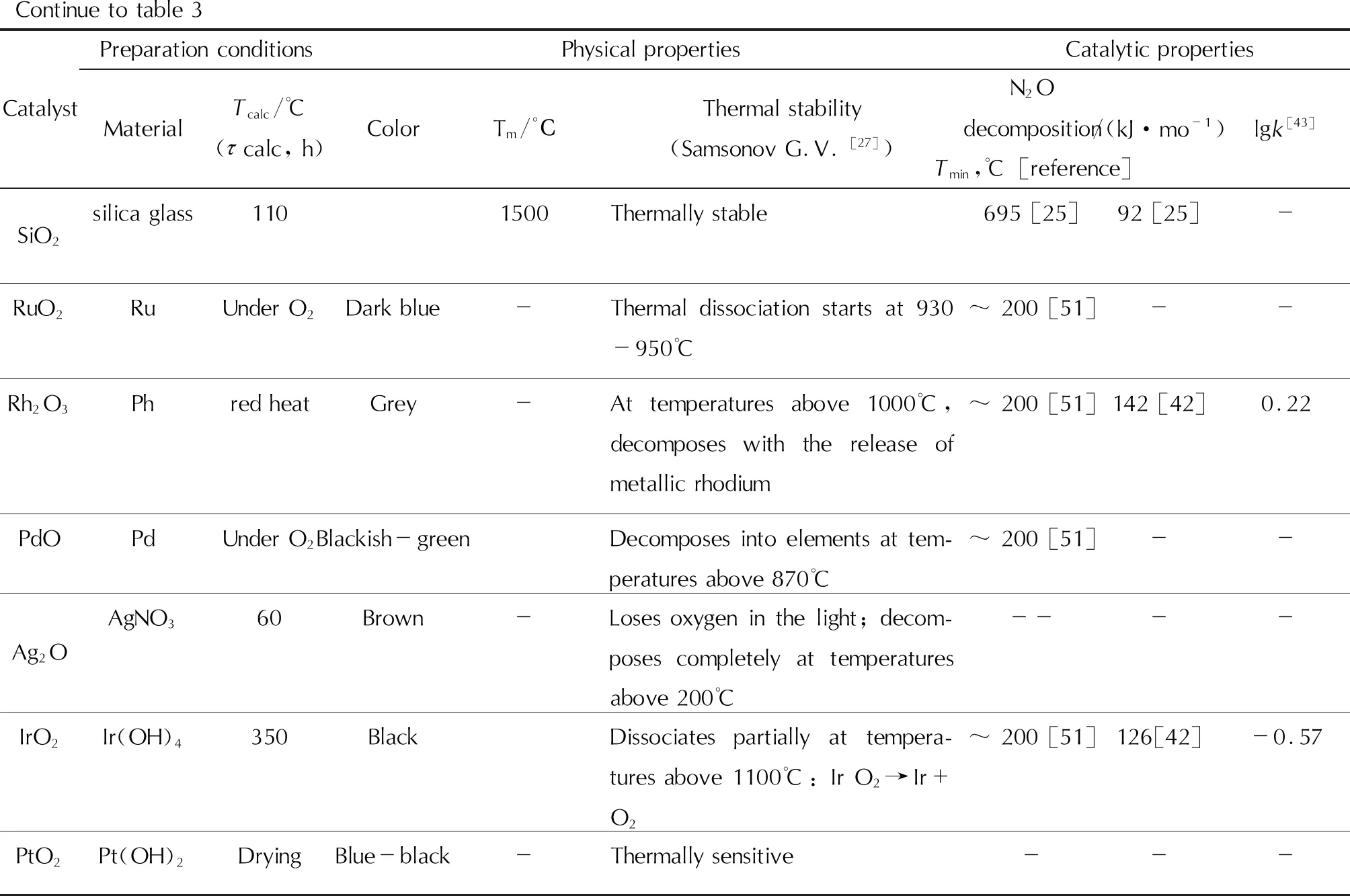
Continuetotable3CatalystPreparationconditionsPhysicalpropertiesCatalyticpropertiesMaterialTcalc/℃(calc,h)ColorTm/°СThermalstability(SamsonovG.V.[27])N2OdecompositionTmin,℃[reference]/(kJ·mo-1)lgk[43]SiO2silicaglass1101500Thermallystable695[25]92[25]-RuO2RuUnderO2Darkblue-Thermaldissociationstartsat930-950℃~200[51]--Rh2O3PhredheatGrey-Attemperaturesabove1000℃,decomposeswiththereleaseofmetallicrhodium~200[51]142[42]0.22PdOPdUnderO2Blackish-greenDecomposesintoelementsattem-peraturesabove870℃~200[51]--Ag2OAgNO360Brown-Losesoxygeninthelight;decom-posescompletelyattemperaturesabove200℃----IrO2Ir(OH)4350BlackDissociatespartiallyattempera-turesabove1100℃:IrO2→Ir+O2~200[51]126[42]-0.57PtO2Pt(OH)2DryingBlue-black-Thermallysensitive---
N2O decomposition catalysts, obtained in the form of complex oxide systems, solid solutions of stoichiometric composition and zeolites, described in literature, are given in Tables 4 and 5. To compare their thermal stability and activity, melting temperatures of individual oxides, methods for obtaining catalysts and minimum N2O decomposition temperatures, indirectly characterizing the catalytic activity of those systems, are presented. It is necessary to exclude catalyst systems, where one of the oxides forming the system has a melting temperature less than 1,100℃ or a low calcination temperature (less than 1,100℃), from the presented and analyzed systems for selection of an N2O decomposition catalyst to be used in LTREs. This is due to the fact that under the influence of high temperatures and pressures in the reactor, they can decompose into components, which will lead to changes in the activity and strength of the catalyst and, as a consequence, to destabilization of engine operation. Evaluating oxide catalyst systems by those criteria, we can assume that the following systems cannot be used to develop the required catalyst:
(1)rare-earth metal manganites due to the thermal sensitivity of MnO2(samples 1—4);
(2)cobalt spinel due to the thermal sensitivity of Co3O4(sample 5);
(3)rare-earth cuprates due to thermal sensitivity of CuO (samples 9—13);
(4)a compound corresponding to the CuMO2formula, where M = Al, Cr, Fe, due to the insufficient thermal stability of Cu2O (samples 14—16);
(5)multicomponent systems with La2O3, corresponding to the La2MnMO6formula, where M = Ni, Cu, Zn, due to the thermal sensitivity of MnO2(samples 20-22), solid solutions NiO·MgO, CoO·ZnO·MgO—due to the low preparation temperature (samples 23, 24), lanthanum-strontium manganite La1-xSrxMnO3(x=0-0.65)—due to thermal sensitivity of MnO2(sample 25).
(6)composition solutions: La2Cu1-xNixO4(0≤x≤1)—due to thermal sensitivity of CuO (sample 26);
(7)multicomponent solid solutions corresponding to the La2Ni1.5M0.5O6formula, where M—Mo, W, Re, due to thermal sensitivity of MoO3, WO3, ReO3(samples 31—33), La2xSrxCuO4(0≤x≤1) due to thermal sensitivity of CuO (sample 34);
(8)La0.8Sr0.2MO3, M=Co, Fe, Mn, Cr or La1.8SrO2CuO4—due to a low temperature of calcination during the process of their obtaining (samples 35—37);
(9)zeolites—due to a low temperature of calcination during preparation (samples 36—42). Besides, the electronic transfer between the reagent and the catalyst is constrained in zeolites due to the fact that metal ions form strong ionic bonds with the oxygen of the zeolitic framework.
Thus, among the considered complex oxide systems, the followings are thermally stable: compounds with La2O3, corresponding to the La2NiO4formula, where La=La, Nd or Pr, as well as multicomponent systems with La2O3, corresponding to the La2TiMO6formula, where M = Ni, Zn.
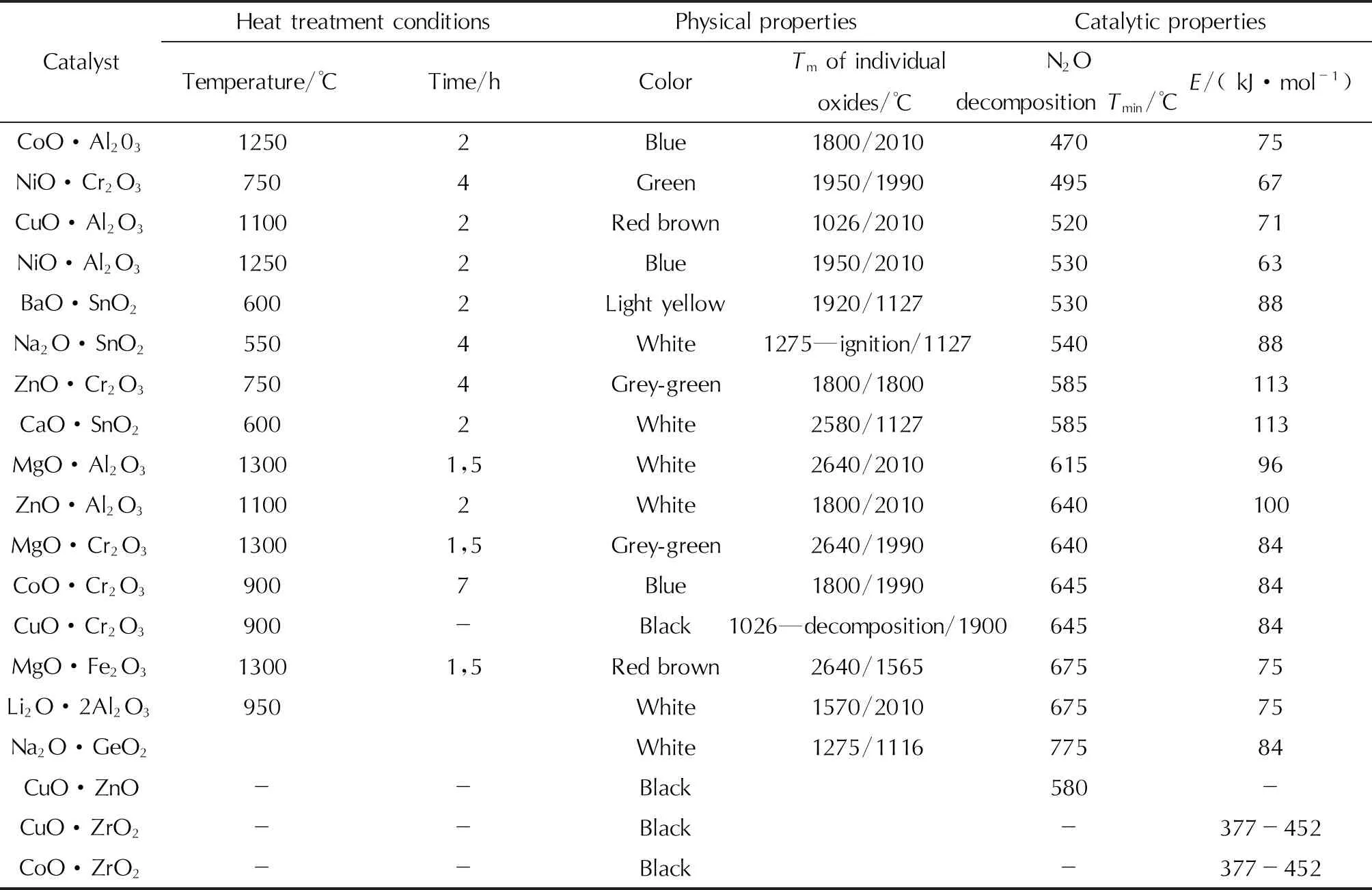
Table 4 Properties of spinel-type oxides [25] and mixed oxides [40]
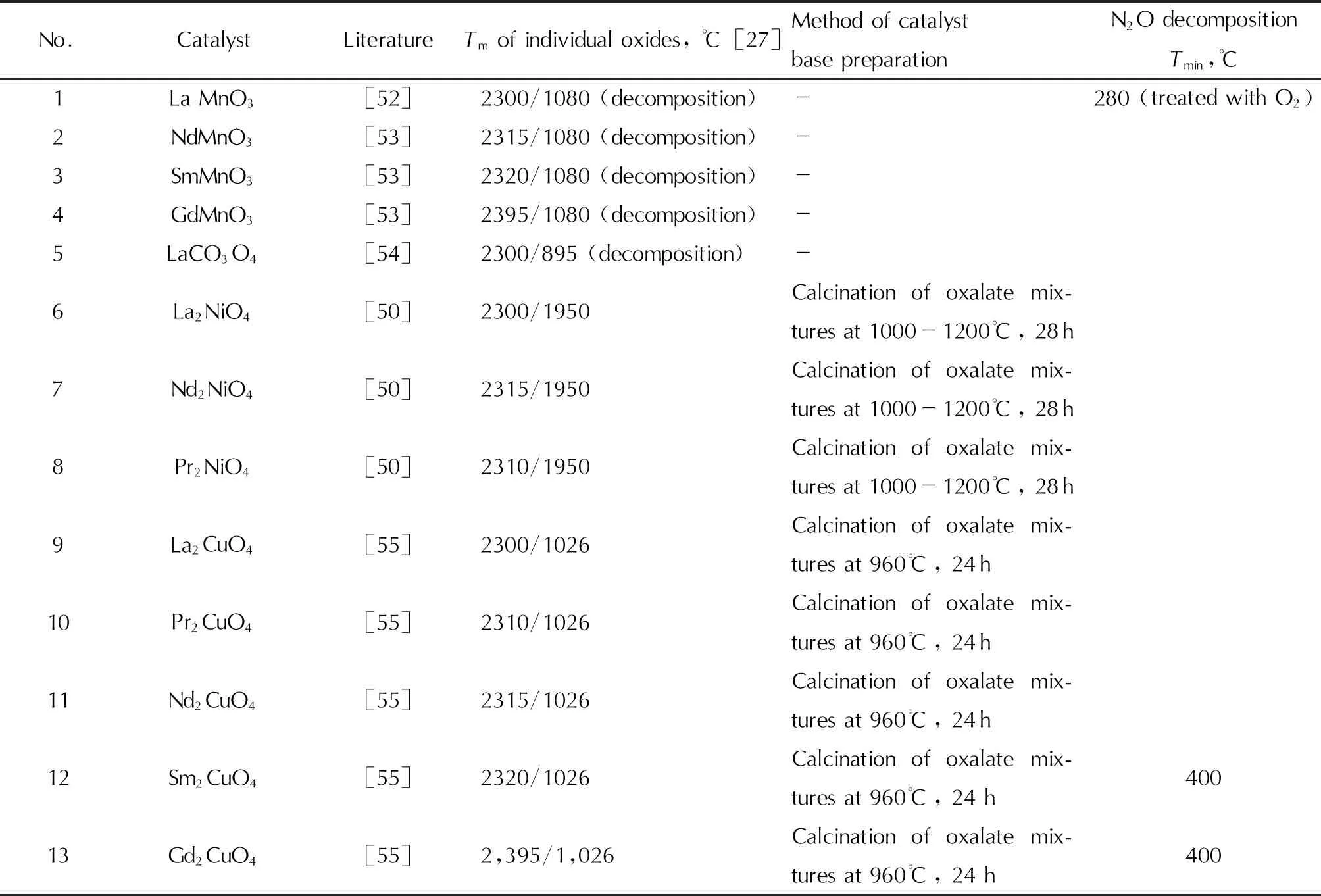
Table 5 Physical and chemical properties of N2O decomposition catalysts prepared on the basis of complex oxides, solid solutions of stoichiometric composition and zeolites
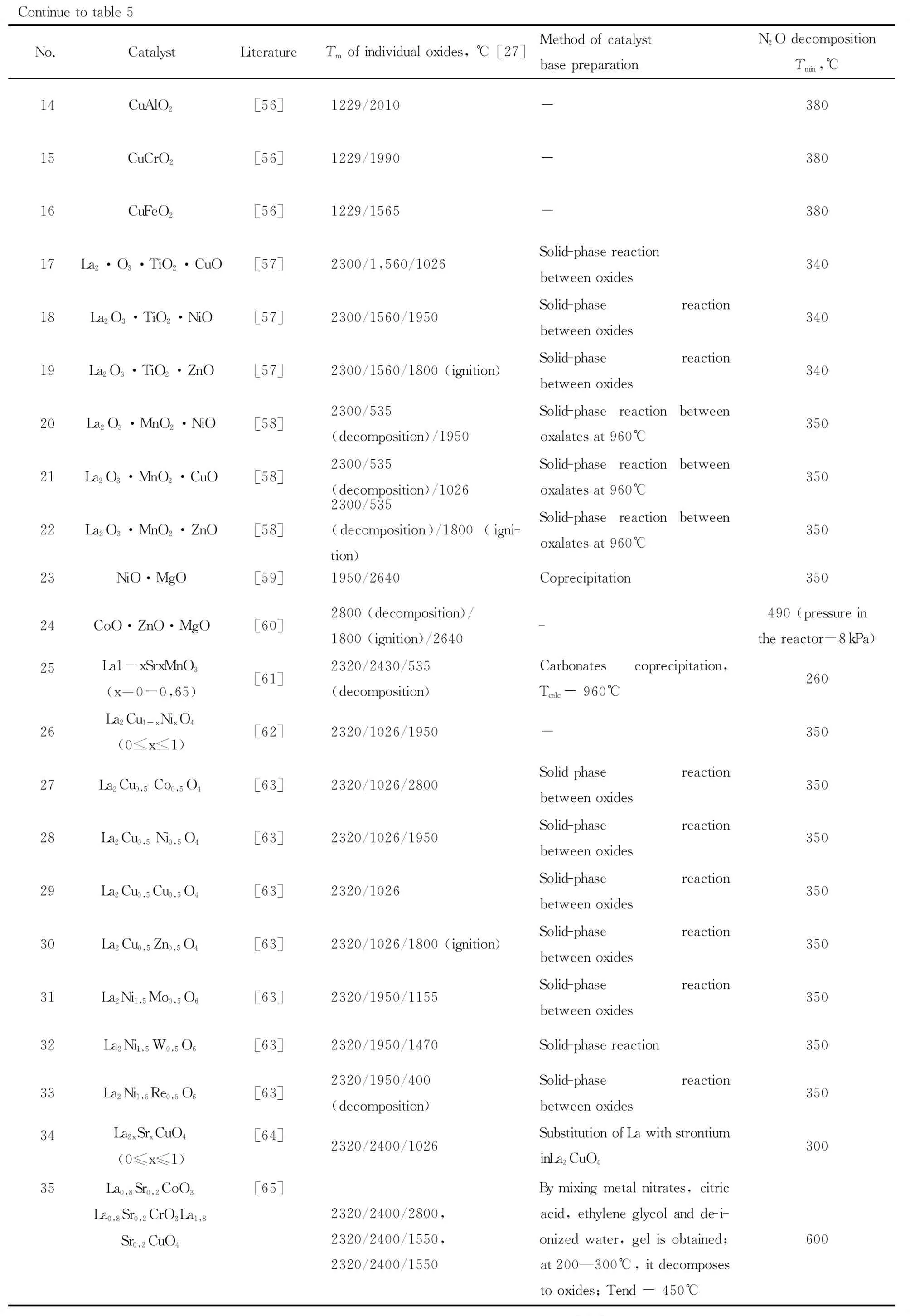
Continuetotable5No.CatalystLiteratureTmofindividualoxides,℃[27]MethodofcatalystbasepreparationN2OdecompositionTmin,℃14CuAlO2[56]1229/2010-38015CuCrO2[56]1229/1990-38016CuFeO2[56]1229/1565-38017La2·O3·TiO2·CuO[57]2300/1,560/1026Solid-phasereactionbetweenoxides34018La2O3·TiO2·NiO[57]2300/1560/1950Solid-phasereactionbetweenoxides34019La2O3·TiO2·ZnO[57]2300/1560/1800(ignition)Solid-phasereactionbetweenoxides34020La2O3·MnO2·NiO[58]2300/535(decomposition)/1950Solid-phasereactionbetweenoxalatesat960℃35021La2O3·MnO2·CuO[58]2300/535(decomposition)/1026Solid-phasereactionbetweenoxalatesat960℃35022La2O3·MnO2·ZnO[58]2300/535(decomposition)/1800(ig-nition)Solid-phasereactionbetweenoxalatesat960℃35023NiO·MgO[59]1950/2640Coprecipitation35024CoO·ZnO·MgO[60]2800(decomposition)/1800(ignition)/2640-490(pressureinthereactor-8kPa)25La1-xSrxMnO3(x=0-0,65)[61]2320/2430/535(decomposition)Carbonatescoprecipitation,Tcalc-960℃26026La2Cu1-xNixO4(0?x?1)[62]2320/1026/1950-35027La2Cu0,5Co0,5O4[63]2320/1026/2800Solid-phasereactionbetweenoxides35028La2Cu0,5Ni0,5O4[63]2320/1026/1950Solid-phasereactionbetweenoxides35029La2Cu0,5Cu0,5O4[63]2320/1026Solid-phasereactionbetweenoxides35030La2Cu0,5Zn0,5O4[63]2320/1026/1800(ignition)Solid-phasereactionbetweenoxides35031La2Ni1,5Mo0,5O6[63]2320/1950/1155Solid-phasereactionbetweenoxides35032La2Ni1,5W0,5O6[63]2320/1950/1470Solid-phasereaction35033La2Ni1,5Re0,5O6[63]2320/1950/400(decomposition)Solid-phasereactionbetweenoxides35034La2xSrxCuO4(0≤x≤1)[64]2320/2400/1026SubstitutionofLawithstron-tiuminLa2CuO430035La0,8Sr0,2CoO3La0,8Sr0,2CrO3La1,8Sr0,2CuO4[65]2320/2400/2800,2320/2400/1550,2320/2400/1550Bymixingmetalnitrates,cit-ricacid,ethyleneglycolandde-ionizedwater,gelisob-tained;at200—300℃,itdecomposestooxides;Tend-450℃600
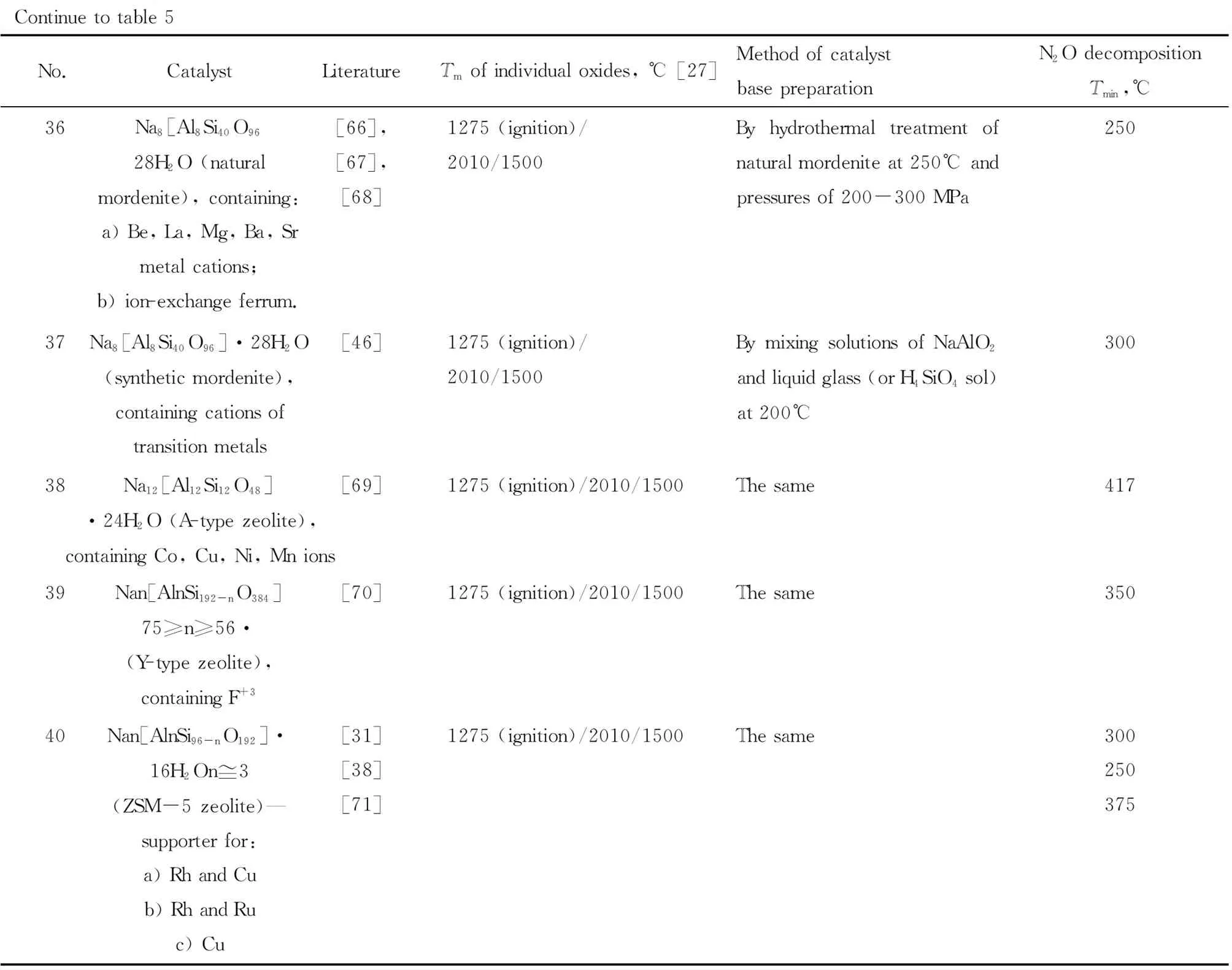
Continuetotable5No.CatalystLiteratureTmofindividualoxides,℃[27]MethodofcatalystbasepreparationN2OdecompositionTmin,℃36Na8[Al8Si40O9628H2O(naturalmordenite),containing:a)Be,La,Mg,Ba,Srmetalcations;b)ion-exchangeferrum.[66],[67],[68]1275(ignition)/2010/1500Byhydrothermaltreatmentofnaturalmordeniteat250℃andpressuresof200-300MPa25037Na8[Al8Si40O96]·28H2O(syntheticmordenite),containingcationsoftransitionmetals[46]1275(ignition)/2010/1500BymixingsolutionsofNaA-lO2andliquidglass(orH4SiO4sol)at200℃30038Na12[Al12Si12O48]·24H2O(A-typezeolite),containingCo,Cu,Ni,Mnions[69]1275(ignition)/2010/1500Thesame41739Nan[AlnSi192-nO384]75≥n≥56·(Y-typezeolite),containingF+3[70]1275(ignition)/2010/1500Thesame35040Nan[AlnSi96-nO192]·16H2On?3(ZSM-5zeolite)—supporterfor:a)RhandCub)RhandRuc)Cu[31][38][71]1275(ignition)/2010/1500Thesame300250375
Results obtained in experimental studies on the selection of a nitrous oxide decomposition catalyst for LTREs will be published in the next article.
5 Summary
The presented requirements to nitrous oxide decomposition catalysts showed the complexity of its operation in LTREs and high requirements to the expected active components of the catalyst.
This is mainly related to the following: the catalyst shall operate in extremely harsh conditions: high temperature (more than 1000℃), an oxidizing environment at high temperatures (nitrous oxide and oxygen), multiple launches (several thousand pulses), impact of various vibration, linear, and shock loads.
For processes involving atomic oxygen, which include the reaction of catalytic decomposition of nitrous oxide, each temperature corresponds to the extremely active state of the heterogeneous catalytic system, at which dissociation tcmperature is equal to the process temperature. According to the selected temperature of the process with the participation of oxygen, it is possible to immediately select elements promising for development of active catalysts. It should be noted that the range of elements selected as promising for development of an active catalyst can be significantly reduced if the elements and their oxides, chemically interacting with the initial final products of the reaction, as well as those elements and oxides that are volatile at the process temperature, are excluded from it.
The given assumption about the possibility of selecting a catalyst based on the dissociation temperature of oxides, along with other properties of the solid phase, was tested on a number of catalytic reactions with acceptable results. Based on the analysis of literature data on N2O catalytic decomposition in various catalyst systems, preliminary selection of catalyst systems for development of a catalyst designed for LTREs was carried out.
The selected substances are: supporter—Al2O3and ZrO2; active substances—Co, Ni, Fe, Pd, Rh, Pt, Ru, Ir, NiO, Fe2O3, RuO2, Rh2O3, PdO, IrO2, PtO2, CoO·Al2O3, La2NiO4, Nd2NiO4, Pr2NiO4, La2O3·TiO2·NiO, La2O3·TiO2·ZnO.
However, since in most cases selection of a catalyst is carried out empirically, it may happen that during experimental studies on catalyst selection it will be necessary to test those oxides and systems, including mixtures based on oxides of manganese, chromium and copper, that were excluded from this series.
Conflictofinterest
The author confirms that the provided information contains no conflicts of interest.

